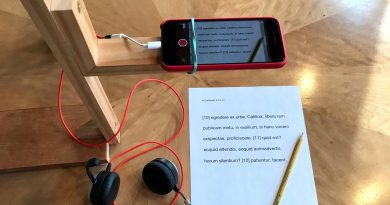Helping students overcome ‘social media speak’
Engaging and relevant exercises delivered via any time, anywhere edtech tools can help students learn to write effectively and leave so-called social media to speak behind
These days, it seems my students can’t let a minute go by without checking TikTok and Instagram or responding to their friend’s latest post on Snapchat. Teens’ widespread access to smartphones for the last decade has fed this fascination with social media and texting. According to Pew Research, 95 percent of teenagers have access to a smartphone, and 45 percent admit to being online ‘almost constantly.’
Though social media platforms can present a wide array of challenges both in and out of the classroom, I wanted to address the indirect impact of students constantly typing on phones and the resulting ‘social media speak.’
As an English teacher, my students’ use of social media shorthand has become a bigger and bigger challenge with every new school year–especially as I see it carrying over into their coursework. Due to heavy reliance on abbreviated words, slang, autocorrect, and a tendency to write too quickly, these bad habits cause students to make a multitude of grammar and spelling mistakes.
That said, as noted by the U.S. Department of Education, “The nature of writing and writing instruction is changing. Technology plays an increasingly important role in how students learn and practice writing in and out of the classroom.”
Unlike me and my peers, today’s high school students were practically born with smartphones in their hands. Therefore, it makes sense that schools like mine are embracing new edtech tools and resources in an effort to boost the writing and reading skills of students, rather than relying on the traditional tools. This turns out to be ideal, as the transition from smartphone to computer might be a little less painful than moving from phone to pencil and paper, especially in the age of COVID-19 and distance learning.
Below are a few tips and benefits I’ve seen with some of the latest edtech tools our school is leveraging right now to help overcome social media speak. These tools are not only empowering me to combat the negative impact social media and text communication have on my students but are unlocking more of their writing potential every day.
Engagement through interest-based writing curriculum
I don’t think I’m being too bold here, but in my experience, students can often find grammar boring. One of the writing curriculum platforms we’re seeing a lot of success with right now focuses on how I engage my students. NoRedInk, an online writing curriculum, provides students with writing exercises based on their interests. This might include a student’s favorite celebrities, Netflix shows, sports, or hobbies. With NoRedInk, I’m seeing firsthand that when my students see topics they’re passionate about, their attention in the entire writing experience is amplified, resulting in a major improvement in proficiency and exam scores.
Through this compelling content, students find my classes more relatable and interesting and in turn, it’s keeping them actively engaged and their writing is constantly improving. Just imagine a grammar quiz featuring singer Billie Eilish or actor Tom Holland. It’s no surprise that students are engaged quickly.
Inspiration through digital video-based discussions
Another way I remain engaged with my students in and out of the classroom is through Flipgrid. Educators can leverage the tool to record writing assignments or provide feedback. Students can then use Flipgrid on their end to respond with a video demonstration or send their teacher a clarifying question. It’s also good to point out that the video aspect is beneficial for students because they’re able to save teacher feedback for later use while keeping track of the improvement of their skills.
Yes, there are other free video-based tools available, but tools like Zoom can only offer educators so much due to their overly-broad functionality, which can actually be limiting. Turning to purpose-built edtech solutions created with both teachers and students in mind improves learning and strengthens teacher-student relationships.
Adaptive and flexible
NoRedInk and Flipgrid also meet my classroom needs because they’re both geographically agnostic. This feature is so critical right now. Online lessons and curriculum allow teachers to easily transition from at-home to in-person learning without losing valuable instructional time. Additionally, their ability to offer students real-time feedback allows me the opportunity to quickly go over specific skill categories in subjects where my students need the most improvement. I am also able to adjust lesson plans, practice exercises, and quizzes based on this real-time data.
These edtech platforms have enabled my students to overcome their excessive use of social media to speak and short-form communication. They have helped me to break bad writing habits and re-train my students to use proper English and become more proficient in their writing skills across the board.
An online, interactive program that meets students where they are now and not where they have traditionally been (paper and pencil) has produced solid results in our English department at Dutch Fork High.
As long as the technology is beneficial and not distracting, we must welcome technology as a friend–not an enemy–in the classroom. After all, ensuring our students evolve into effective communicators is nothing to LOL about.
Source: https://www.eschoolnews.com/2020/11/12/helping-students-overcome-social-media-speak/2/




